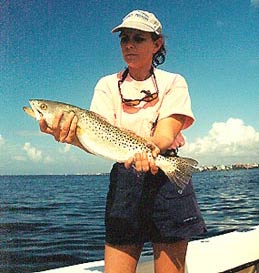Flats
FINDING FANTASTIC FLATS FISHING
Saltwater flats — shallow bottom rising from surrounding depths — hold abundant angling opportunity if you know what to look for. I generally take a broad, sweeping view and try to spot differences in bottom that  help me know what’s below the surface. I also look for differences in the water that might reveal fish movement or tide rips.
help me know what’s below the surface. I also look for differences in the water that might reveal fish movement or tide rips.
Predators such as snook, redfish and trout love edges because they provide ambush points from which to hide and nab passing baits. Think about it: If you were going to grab someone, would you stand out in the open where they could see you? No, you’d hide and grab them as they walked by you.
Oyster bars and sea grass beds provide fish with great ambush opportunities,plus they’re breeding grounds for several baitfish and crustacean species. In the grass, look for sand spots or holes that are deeper than the surrounding bottom. The boundary where sand meets grass creates an ideal ambush edge, so look for strikes right at this point. (As the tide falls, fish pile into these sandy “potholes” for low-water refuge.) Oyster bars offer similar scenarios, as fish wait behind the structures and grab baitfish and crustaceans that wash over and around the edges with the tide.
Sometimes, a spot just looks fishy. Maybe it’s a prominent oyster bar or a broad area of sand holes with tide rips. I’d anchor uptide and cast back to the tide rips or the structure. When fishing the flats, if you see bait fish flashing in the water, raining on the surface or being hit by diving birds, fish the area. Fish will congregate near available food sources.
Because predators usually feed into the tide, baits get the best reception when they come downcurrent to the fish. I like to position upwind of a spot and drift fish by casting downwind and to the edges. If you can’t see the bottom, fan cast around on the downwind side of the boat.
If you get a bite, quietly drop the anchor and work the area. Another technique is drop markers when you get bites. When the bites stop, go back and drift your markers again.
Some things to remember:
- The higher the tide, the further onto the flats fish will move. As the water drops, they will move to the deeper edges of the flat.
- Minimizing noise means maximizing your opportunities.
- Don’t waste time in unproductive areas. If the bite stops, or never starts at all, go find another spot.
- The flats hold lots of potential and understanding what fish want will give you the “edge.”
DON’T LEAVE HOME WITHOUT ‘EM
Three Favorite Inshore Lures By CAPT. BILL MILLER
One of the biggest questions facing inshore anglers is “What lures should I use?” Well, various scenarios will require various lures, but for ultimate flats fishing diversity, the following lure types will enable you to take advantage of just about any situation you encounter.
• Topwaters: Known for eliciting aggressive,high-visibility strikes, these lures work best in low-light scenarios such as mornings, late afternoons or cloudy conditions. Resist the urge to jerk the lure on a strike, as doing so usually pulls the topwater away from the fish and sends it zipping back in your direction. Not only does this create a hazard for you and your partner, but also it leaves no chance for hooking a fish that is searching for the bait it just tried to eat.
The best reaction to a topwater strike is to reel until you feel the fish and then simply raise the rod to set the hook. Fish often miss topwaters on their first strike, so be patient and they’ll usually return for the coup de gras. On a miss, wait until the ripples subside, twitch the bait and get ready for an explosion.
Worked with a “walking the dog” action, topwaters are effective fish locators. After a couple of misses toss a jig or some other subsurface bait into the strike zone and you’ll usually connect.
• Spoons: With long casting distances and simple retrieves, spoons enable you to cover a lot of area and locate fish. A great lure for windy conditions, you just throw it out and reel it back. Let the spoon sink for a few seconds in deeper water and vary the retrieve speed to determine what the fish prefer.
When fishing spoons over grass and around mangroves, single hook, weedless models are necessary, as clinging vegetation ruins the presentation. Also, a spoon’s inherent spinning is what produces the attracting flash, but this action also twists your line. Eliminate line twist by attaching a split ring and barrel swivel to the spoon. Tie your leader to the swivel, so the spoon spins independently.
Although I prefer a naked spoon, some models have a feather on the hook. You can also attach a grub tail or jerk bait to the hook for additional color, action and increased buoyancy (slower fall).
• Rubber Tail Jig: One of the most diverse lures, a jig allows you to cover the entire water column. Standard retrieve should be a little hop just off bottom, but over grass, or other snags, bounce your jig across the top. If your jig keeps hanging in the obstruction, reduce its sinking distance with a “cast and count” system. When the lure hits water, count to five and start retrieving. If you snag the bottom, give the next cast a 4-count before retrieving. Keep reducing the count until you eliminate the snags.
Another option is suspending the jig below a popping cork to keep it just above the grass. Work the jig back by popping the cork the whole way. The noise sounds like a feeding fish. When others come to investigate, they see the jig and attack it.
Over sand, let it hit bottom and make little “puffs.” This looks like a crab or some other critter digging into the sand and predators usually come to investigate. When fish are feeding aggressively, most any jig will draw strikes, but when the fish need a little coaxing, scented jig tails can help attract attention. Also, color often makes a big difference, so experiment and find what works.































